Leaving Bangkok
After Prachuap we had a short stay in east Bangkok before getting to Ho Chi Minh City. Our last day in Bangkok was the most difficult we’ve had so far. Our flight was in the late afternoon and that same morning I realized that I would need a visa to enter Vietnam (Kanako and Asa with Japanese passports are exempt since we were staying less than 2 weeks). So I had to get an expedited online visa, a couple hours later rush off to the shopping mall to find a place to print it. Then rush back, grab a taxi for the airport in the pouring rain and get stuck in Bangkok traffic on the way. Finally get to check-in counter, through immigration, security and run run run to the gate at the far end of the terminal with 30 minutes to departure only to get there out of breath and wait because the plane was delayed by an hour. Then we got to immigration in Ho Chi Minh City to realize that I forgot the passport photo for the visa was in our checked-in luggage so I had to pay an additional fee. All told, I think what should have cost $25 for the visa, turned into $125.
But we made it.
A city of motorbikes
Actually as the plane descended to the airport I could see them from the window. There just seem to be so many more motorbikes than Bangkok or anywhere else we had been. Then later in the Uber from the airport to the guesthouse it was clear just how many there were. But not until the next morning when we took to the streets for a walk around was the madness of it starting to dawn on us.
In a city of 9 million people it’s surprising how few traffic lights we saw, and even where there were traffic lights these were treated as suggestions, often ignored. Drivers always start before the light changes green and keep driving after it turns red. This transition time is managed as it is in all the other intersections without traffic lights: with a chaos driven and tempered only by the instinct of survival. In Bangkok it’s very rare to hear honking horns even in bumper-to-bumper traffic, but in Vietnam honking is constant, and the bigger the vehicle (trucks and buses) the louder and more frequent is the honking.
You can also see it on how people dress. Though the weather was upper 80’s and humidity was the same, those on motorbikes were often completely covered, mostly to keep the dust off. Women wore slippers and short stockings; to cover pants or skirt they wore a long over-skirt that’s open in the back like an apron; a light sweatshirt with a hood; detached sleeves, light gloves, face mask to cover nose and mouth, or if you don’t have a hooded sweatshirt wear a full head covering with a small slit for eyes.
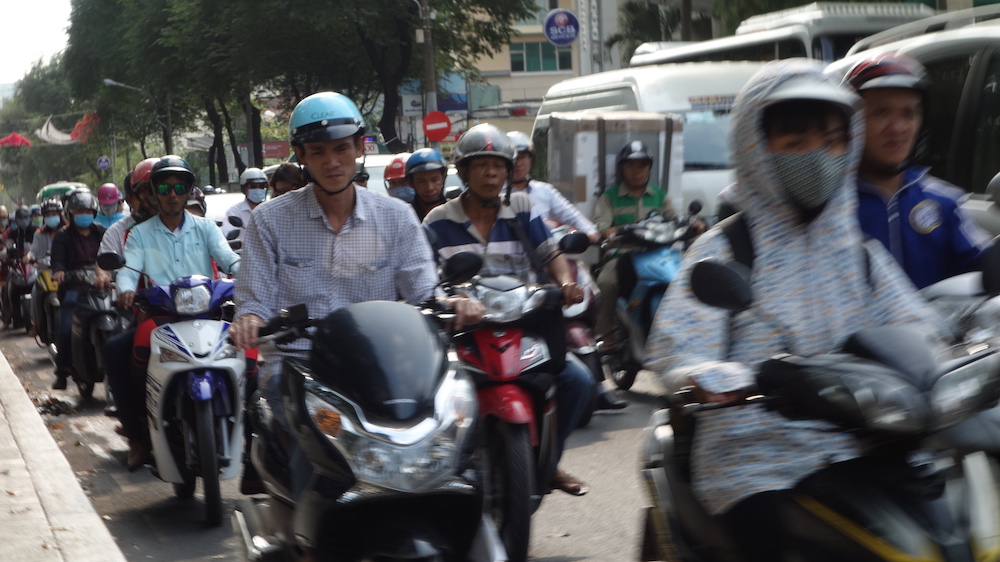 Motorbikes
Motorbikes
The city has accommodated itself to the reality of motorbikes. Every sidewalk curb has a graduated incline so motorbikes can hop up and park on the sidewalks. So pedestrians don’t really own the sidewalk, because half the time you have to walk in the street around park bikes. In places and times when the traffic really backs up motorbikes will simply take to speeding on the sidewalks.
Crossing big roads with no traffic lights is something you see locals do with relative ease, but for the unaccustomed seems impossible, suicidal or at least insane. I am a New Yorker, I was jaycrawling before I could walk so I had some confidence. One day I was walking solo to a coworking spot 15 mins from our guesthouse and had to cross a six-lane road packed with 95% motorbikes whizzing by. I almost died twice. So the technique is just to wait for the right moment and go for it, stop or move forward, never go backwards. Or you can just wait until someone else is crossing and walk downstream of them.
I didn’t take a lot of photos in the city because I was mostly focused on trying to keep us all alive.
A country of coffeeshops
I don’t know why there are so many, but the coffeeshops are everywhere in Vietnam. From fancy ones to national franchises to just small simple coffeeshops. There are tons of these small simple ones, and they have two basic arrangements: short wooden stool chairs (maybe 10-12 inches high) set around low rectangular tables; OR semi-reclined plastic chairs facing the street with small tables between them — I guess the idea is that it’s more interesting to sip your coffee and face the street than face the same friend(s) you go to this place with every time.
As a remote worker, I am always on the lookout for coffeeshops, and there are basically three main requirements — in order of importance: 1) comfortable chair and table (a comfortable chair without a table is great but not for working); 2) wifi — reliable connection is more important than speed; 3) coffee or tea.
February 9th was the 2018 AFC U23 final match (Asian men’s soccer under-23), and Vietnam was facing Uzbekistan. Everyone was watching the late afternoon game being played in snowy Beijing. We looked around the neighborhood and finally found a place with a tv and space to sit and join in the oohs and aahs of the game. Vietnam lost just towards the end. One customer at the coffeeshop was so angry he broke a table before storming out — it captured the mood of the room, and probably of the country. Must have been quite a win for Uzbeks though.
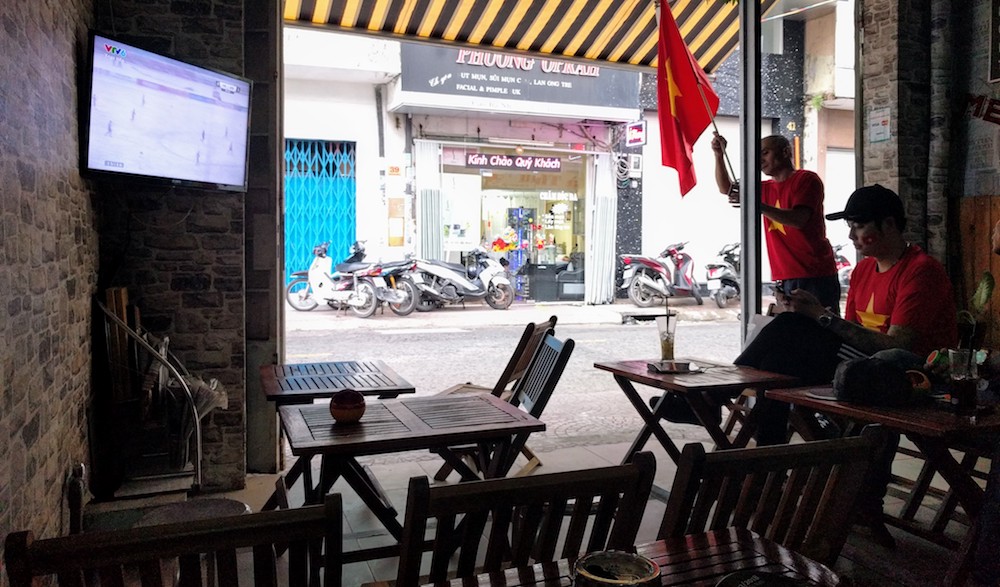 Watching the soccer match
Watching the soccer match
Water Puppets
Vietnamese water puppetry actually is from the Hanoi region, where it originated in the in the wet marshy villages of the Red River delta. But seeing it in Ho Chi Minh City at a very touristy theater was surprisingly fun and entertaining.
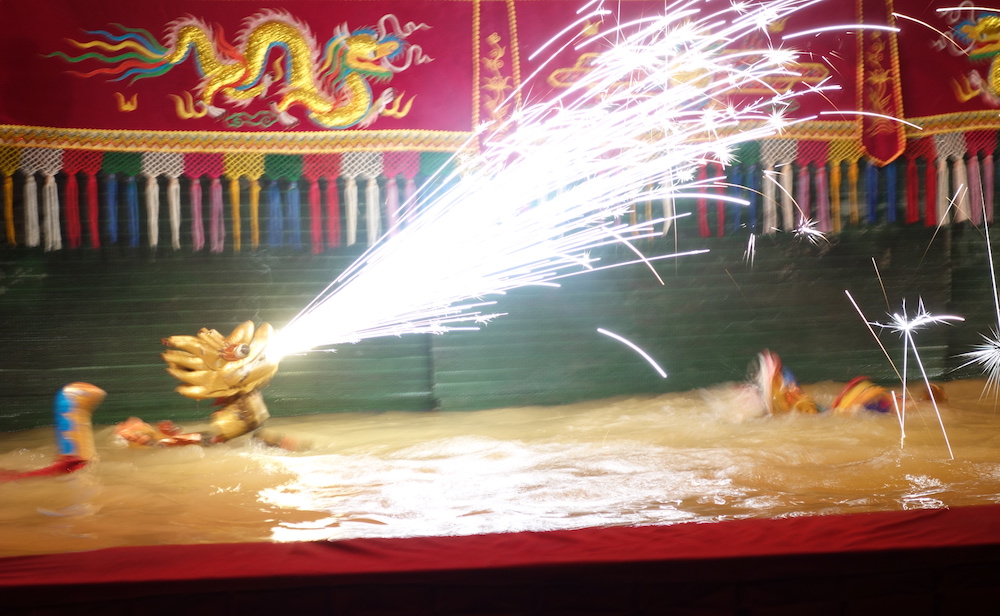 Some pyrotechnics at the water puppet show
Some pyrotechnics at the water puppet show
Hidden behind a curtain, puppeteers stand in waist-high water manipulating different kinds of puppets to make their characters dance, swim, fish etc. It’s a very different experience than other puppet shows, because the emphasis is on technical showmanship — the craft that goes into making the puppets for clever underwater manipulation is more important than the realism of the gestures and movements. But like any other puppet show the characters are accompanied by live musicians that also give voice to the characters.
The Train
We took the 2nd class train from the central Bangkok station ambling along making several stops and arrived about 7 hours later in Prachuap Khiri Khan. Prachuap is a beach town which we picked because it’s relatively quiet but known to be popular for locals; just south of Hua Hin a much bigger and pricier tourist destination.
Prachuap Town
The town has a long stretch of beach along a wide bay between two rocky promontories. The beach at Prachuap is basically unswimmable. The swimming beach is in the next bay to the south, Ao Manao, but it’s located within a Thai air force base. It’s accessible to locals and foreigners but you have to do a quick passport check before entering.
 Islands in Prachuap Bay
Islands in Prachuap Bay
I think we were there right before high season. It was quiet. Guesthouses looked mostly empty. Tourists could be spotted only here and there.
Our first guesthouse was a simple bed and breakfast just down the street from the train station, and the central night market was just a couple blocks away. On weekends there’s a long night market that takes over the main beachfront street. Then, there’s another market on the other side of the train station that’s open a few days a week.
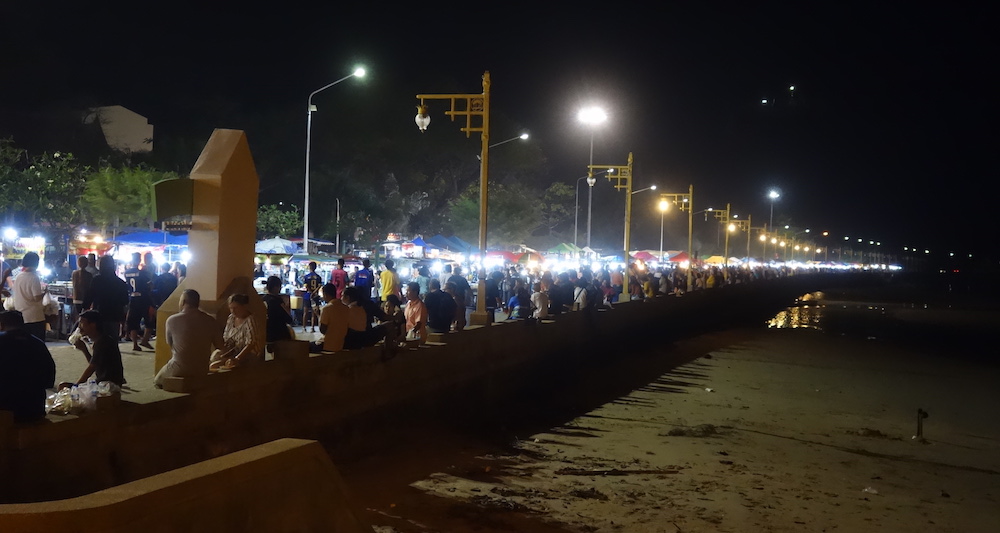 Night market
Night market
Night markets are a Thai necessity. In Indonesia most “wet markets” we saw (selling fresh meat and produce) open very early and close mid-morning. In Thailand it’s more often to find them open in the afternoon and by late afternoon they turn into night markets selling prepared foods, fresh fruit, desserts and drinks. Thai people regularly eat dinner at these vendor stalls or takeaway to eat at home. So it makes it easier to find food as a foreigner — while menus are rarely in English, they often have pictures showing familiar dishes.
Ao Noi
Prachuap has a small mountain near the beach with temple at its peak, it’s a regular attraction but has become overtaken by groups of monkeys. We were told they can be aggressive and so we skipped it.
Instead we went north to the forked promontory where there is a small cove, Ao Noi. At one end there is a temple and nearby a well-known cave with large reclining Buddha statues. The temple has a nice setting and nearby to the south-facing beach is a set of monks’ quarters.
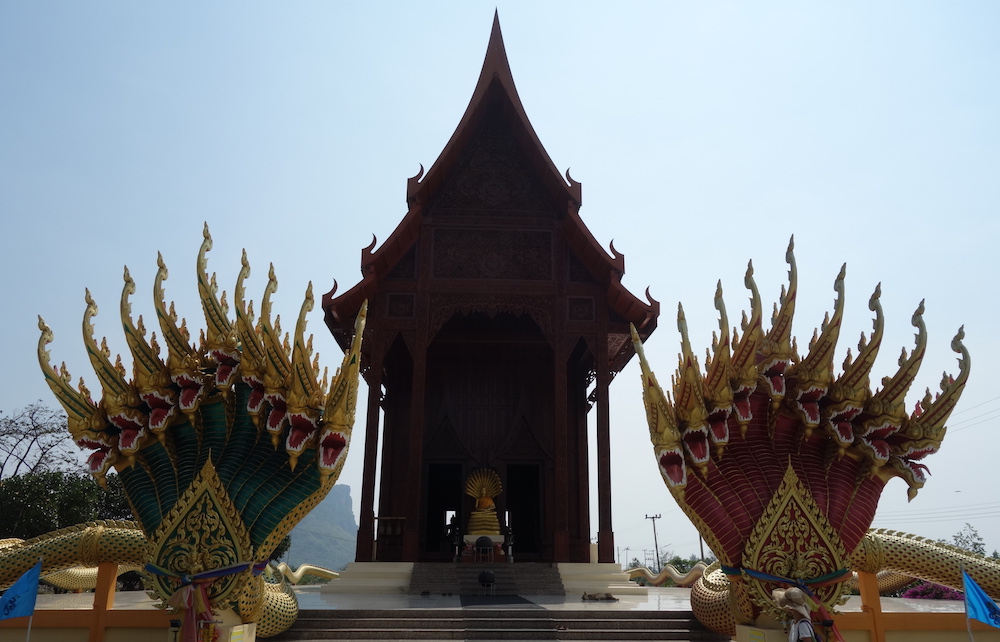 Wat Ao Noi
Wat Ao Noi
The southern fork of the promontory is Khao Ta Mong Lai, a forest park with a (retired?) scout camp. We did the short shoreline hike and skipped stones over the gentle waves. On both sides of the promontory you can see the fishing boats parked along the beach front, I suppose they must fish a lot at night and early morning. On our way back to Prachuap town we stopped for lunch at a small restaurant and enjoyed the best seafood salad we’ve had with some very tender squid and octopus — spicy!
 Ao Noi Bay
Ao Noi Bay
Children’s Day
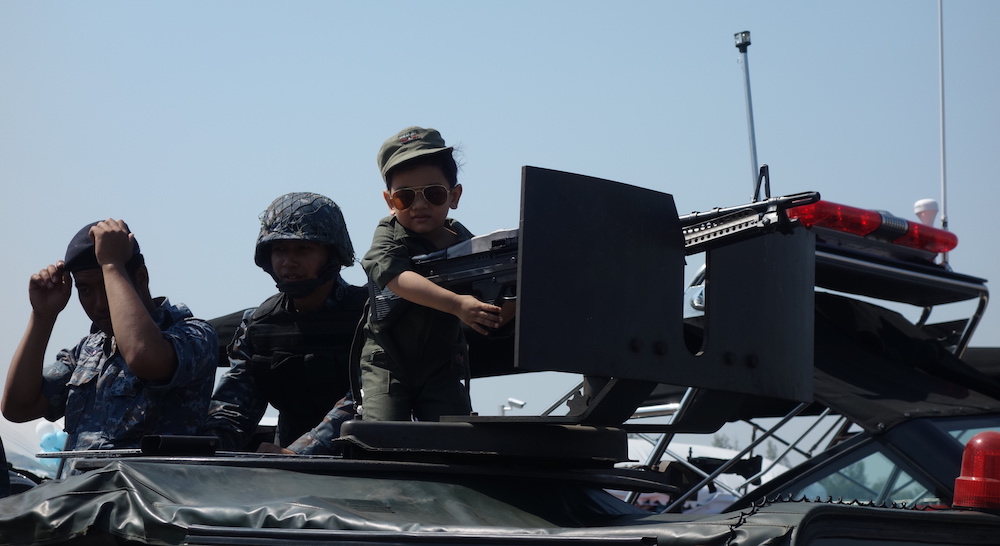 Posing on the artillery jeep
Posing on the artillery jeep
The second Saturday of January is Children’s Day in Thailand. Though we had no idea about it beforehand, it turned out to be a great thing. Our hosts had told us to go to the air force base because there would be a lot of events for kids. So we filed on to the long line of cars and motorbikes to parade into the base to find thousands of people near the runway watching some of the base’s planes, fighter jets, artillery-packed jeeps and other vehicles. Asa was excited to see the plane’s up close got to sit on a forklift.
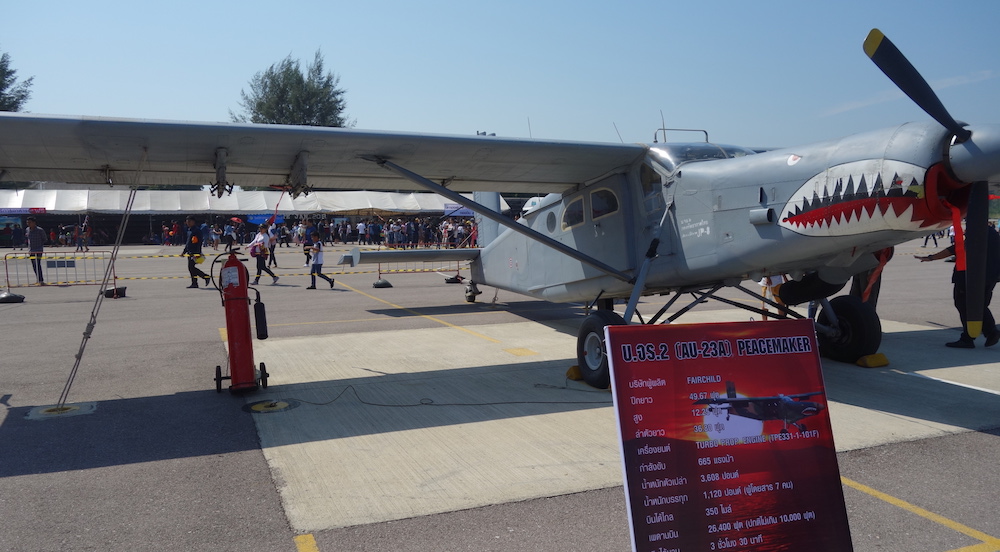 Peacemaker
Peacemaker
Being on sunny military base surrounded by families — it reminded us of being in Hawaii.
Elephants!
Our second guesthouse was far from the coast and run by a very friendly Vietnamese American man. He designed the place mostly by himself, and built (with some help), about six very nice guesthouses on his property. He also loves food and cooking and built a little brick pizza oven. Delicious!
One afternoon he offered to bring us along with his family to Kui Buri National Park, a wildlife sanctuary known for its elephants. We hopped on one of the pickup trucks that guide visitors around the park to spot the herds. We stopped at a few different view points and then finally got to a promising spot. Slowly, carefully a group of 30-40 came out of a little gully and onto a little plain. They seemed to be of different ages and one of the guides said the youngest was about a year old. These were wild elephants, as wild as they get these days. In Phuket we saw elephants along the road that were being ridden, hosed down or going through some kind of training for shows. This was something else.
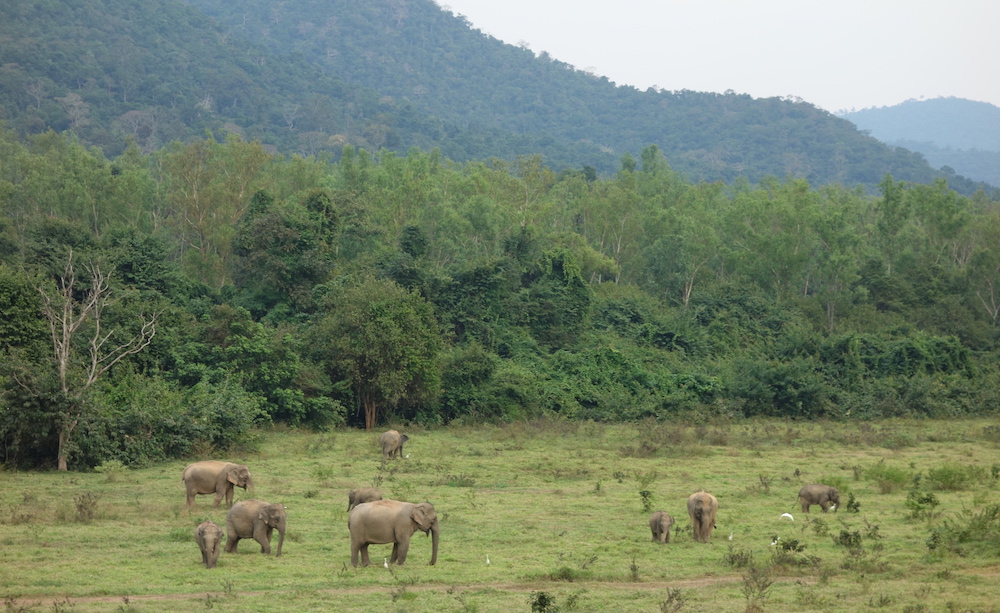 Chang (elephants)
Chang (elephants)
Though they could see us they showed little curiosity — at the closest they came to about 50 meters from where we stood snapping pictures. In another spot we saw a smaller group and were quickly ushered back in the truck because according to the guide the alpha bull was in heat.
On the way to Kui Buri we passed by the rolling hills of pineapple — the region is known to produce some of the best in the country. We bought some before boarding the long train ride back to Bangkok the next day.
A big city
Because it’s a central hub in Southeast Asia we actually stayed in Bangkok three times during out trip. First in the west side (near Wutthakat station), then the east side (near On Nut station), and later in the March we stayed in the north (near Wat Nonthaburi).
Our first stay we arrived right before New Year’s and had an uneventful New Year’s Eve, saw some fireworks in the distance from our Airbnb apartment. Maybe because we were coming from the small confines of Luang Prabang, we were surprised by Bangkok. In Southeast Asia, Jakarta still has the highest population while Bangkok and Ho Chi Minh City, close in size, are both tied for second.
(Note skip this paragraph if you find population stats boring, for some reason it fascinates me): I haven’t found a reliable reference for the size of these three mega cities, since all of them are growing rapidly — and I won’t cite any sources. Roughly… Jakarta has 10 - 11 million (metro area, over 30M), while Bangkok and Ho Chi Minh City have populations between 8.5 and 9.5 million,. Ho Chi Minh City has a larger metro area population nearly 20 million, compared to Bangkok about 15 million.)
So Bangkok is huge and growing in all directions. In the north we could see a huge new highway line being constructed, and in the west another commuter train line. Yet Bangkok has remarkably good infrastructure. Our only point of comparison in Southeast Asia was Kuala Lumpur (only 1.5M). Compared to KL, Bangkok seems to have a longer history of development and greater investment in infrastructure.
But the infrastructure is a mixture of old and new. We rode old rickety city buses with creaking wooden slat flooring, and onboard fare collectors with little encoded tickets, and on the same bus you will find newly mounted LCD screens to inform passengers of the upcoming electronic card system. The subway systems of Bangkok were clean, new and efficient, though a little expensive if going for a long ride. However the central train station was quite old and the train cabins could really use an upgrade.
Some sights
It felt like we didn’t visit a lot of the sights in Bangkok, mostly we were just exploring big city life. Some highlights…
Wat Paknam Bhasicharoen
Walking distance from our Airbnb apartment, this royal temple complex houses a large multi-level museum inside the enormous white stupa that is visible all around the surrounding area. The top level of the museum has a large surreal green glass pagoda and painted ceiling, while the lower levels exhibit collections of gifts and donations to royal monks over many decades — statues, sculptures, jewelry, clocks, old classic cars. The sizable educational complex nearby attracts local monks, nuns and foreigners seeking to learn the meditation practices of a famous deceased abbot of Wat Paknam.
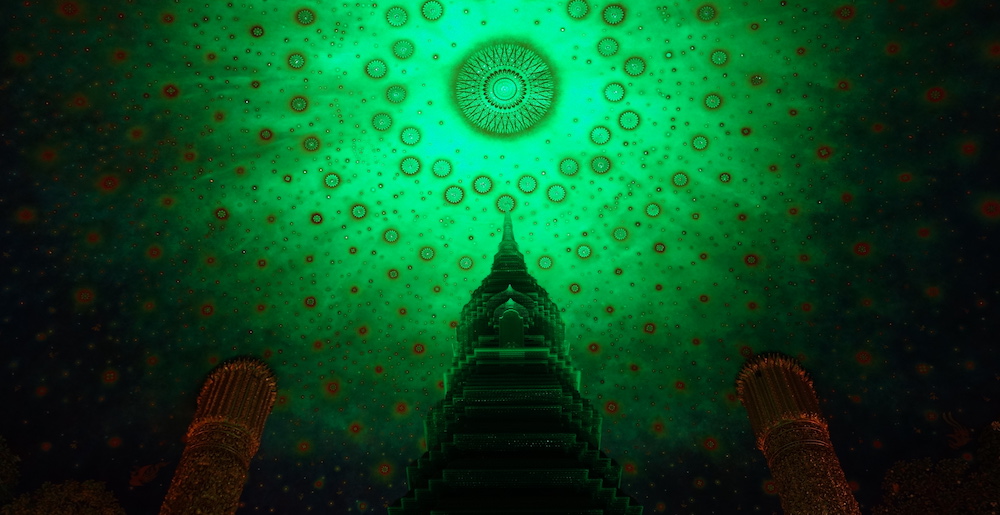 Ceiling of stupa in Wat Paknam
Ceiling of stupa in Wat Paknam
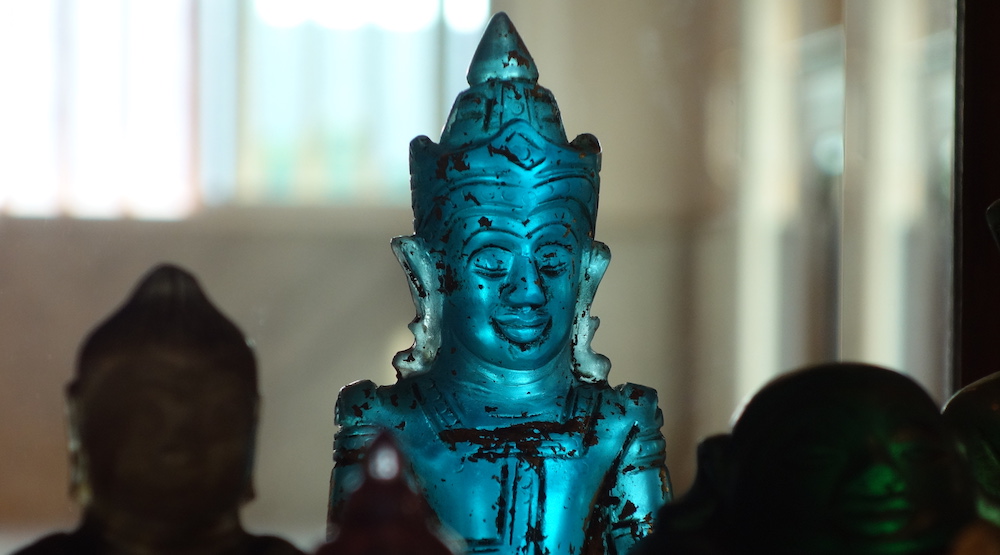 One of the statuettes in collection in Wat Paknam museum
One of the statuettes in collection in Wat Paknam museum
Wat Arun Ratchawararam Ratchawaramahawihan
We arrived by river ferry at Wat Arun, one of the more famous temples in Bangkok. The temple is meticulously adorned with inlaid ceramic pieces to create patterns and sculptures covering every surface of the structure. The original temple on the site was uilt many centuries ago and has gone through a series of changes and restorations so it was hard to say how much of the current temple resembles the original.
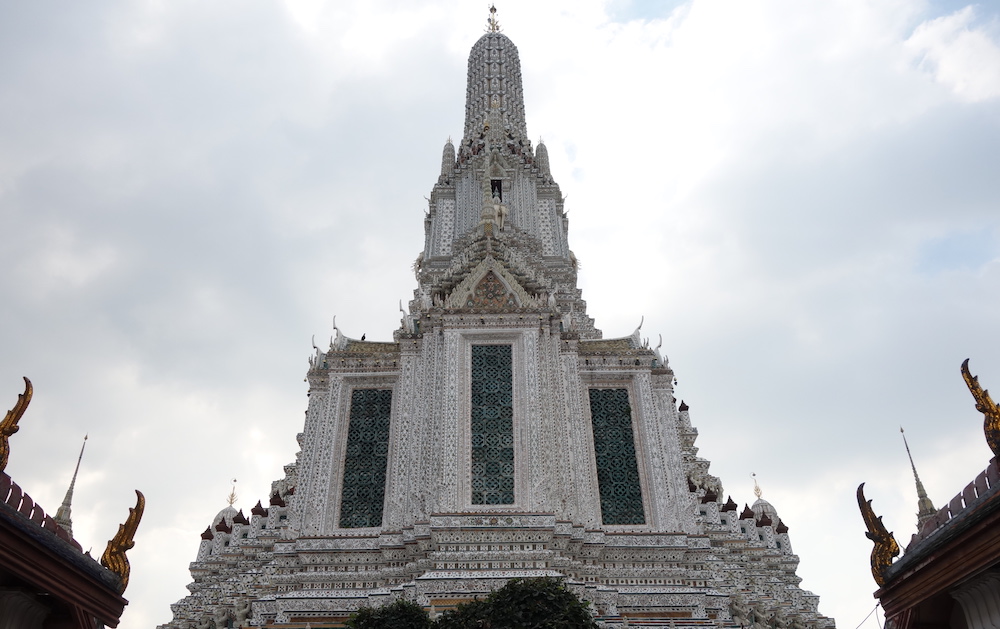 Wat Arun
Wat Arun
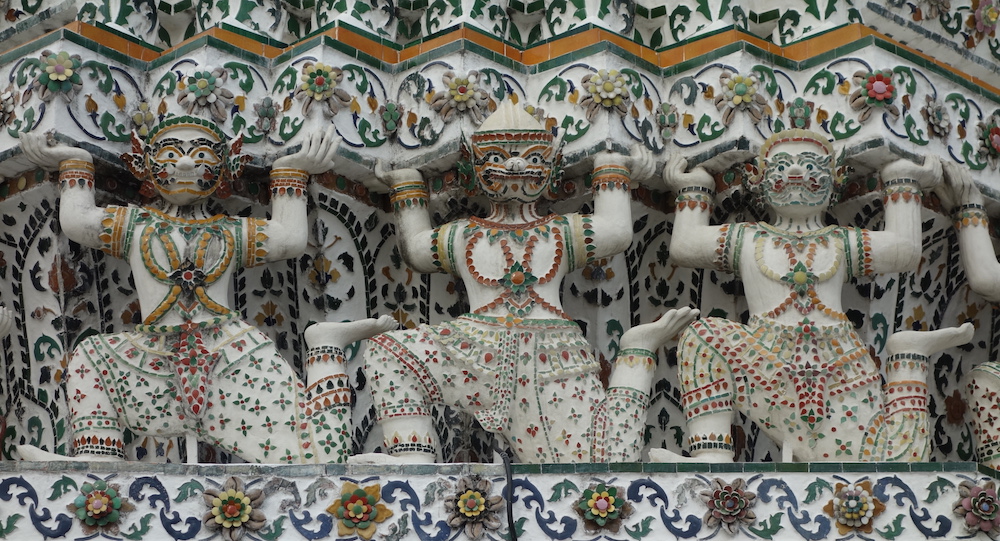 Wat Arun details
Wat Arun details
Jim Thompson House
Jim Thompson was an American architect born in 1906, after WWII he settled in Thailand and became a heavily influential silk merchant. He brought pieces of traditional Thai homes from different parts of Thailand to be reconstructed on his property in Bangkok to serve as a exhibit to his special collection and his personal residence. The guided tour was quite interesting though it focused more on the structure’s artwork and architecture, not much about the silk pieces that made them possible.
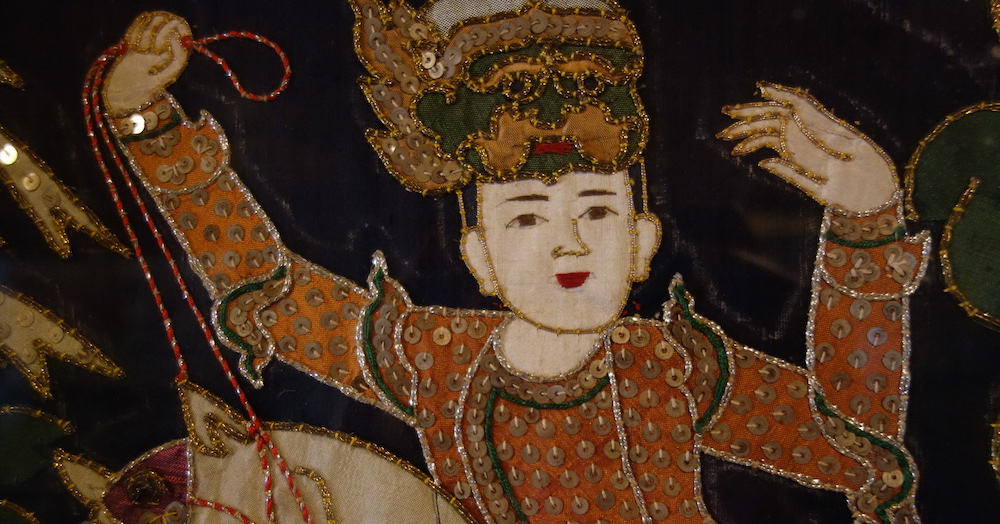 From the Thompson House collection
From the Thompson House collection
A city with many faces
On New Year’s day we took the subway to a shopping mall in Silom, one of the districts with a large percentage of Japanese residents. The shopping mall was our destination for some Japanese New Year’s activities: mochi pounding and tasting. Outside the mall you can find several Japanese restaurants, shops, markets and of course lots of Japanese people.
Actually sometimes Bangkok had a little of the feeling of being in Tokyo, glassy skyscrapers towering over clean, well-groomed parks and streets, and a ridiculous number of 7-Elevens. In other parts Bangkok has the mixture of grunge, historical character and diversity of New York City. Then in another part you will find the familiar smells and sights like a Chinatown in any other city.
But then seeing motor boats speed along the wide Chao Phraya river and the crisscrossing canals that interpenetrate the neighborhoods, bringing along floating markets, cruising crocodiles, and snakes! – taking it all in Bangkok feels authentically Thai and yet completely unlike anywhere else in Thailand, unlike any city in the world.
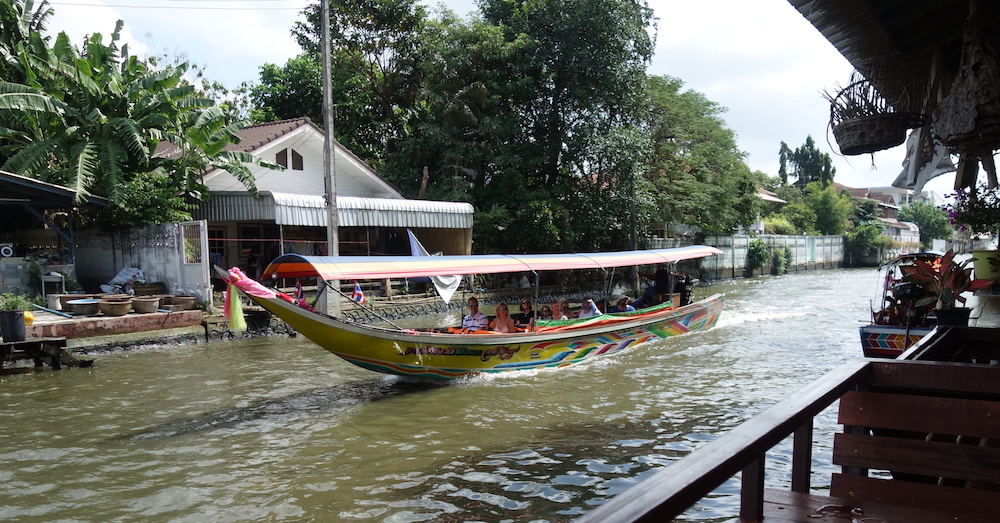 One of the river boats speeding past
One of the river boats speeding past
When the sun is up, hot and hazy Bangkok can have a business-y feel to it, but when the sun sinks low everything seems to change. Shop doors close, gates come down and then the vendors come out to claim the sidewalks, setting up tables, cooking food, selling prepared food, fruit, desserts, new and used clothes and shoes, shoe repair, watch repair, etc. etc. etc.
By night, all of Bangkok starts to feel like one big interconnected night market, filling every stretch of sidewalk, every alleyway, every open patch of dirt. Unused fields are quickly claimed for night markets. In east Bangkok we went to the Rot Fai Train Night Market (by my estimate it covers an area of about 10 soccer fields), packed with vendors and strolling buyers — mostly Thai locals.
Still, in seeing many sides of Bangkok, in looking back, I wonder how many we missed.
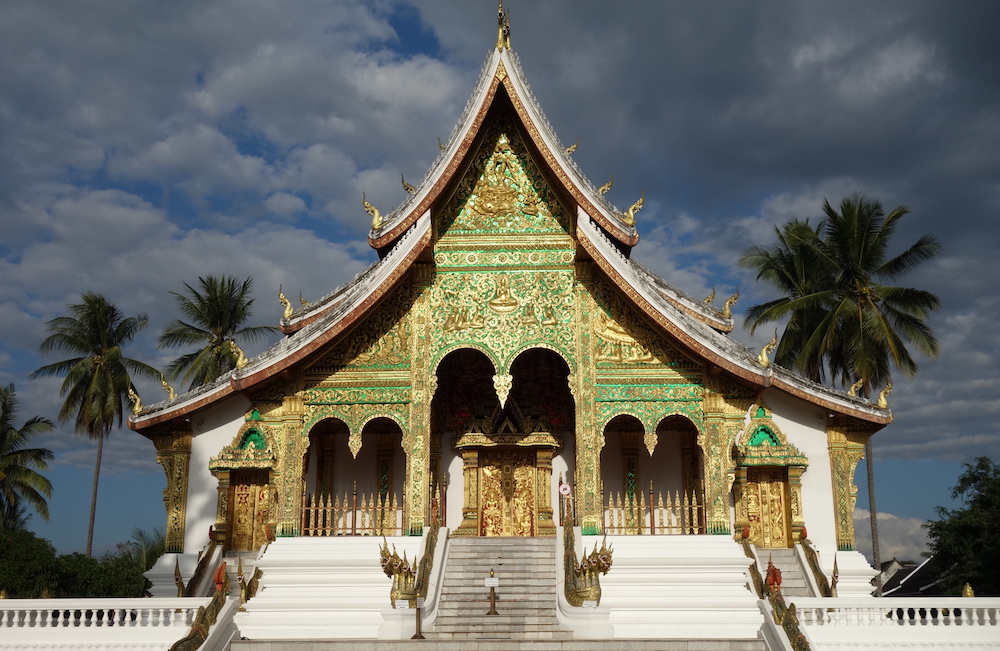 Haw Pha Bang, royal temple monument
Haw Pha Bang, royal temple monument
We saw very little of Laos, and spent a relatively short time there. But it felt that we saw the best it could offer, a balance of accessibility and cultural exposure. I took more pictures in Luang Prabang than in Phuket, Chiang Mai and Sukhothai combined. So it really seemed to us that we packed in a lot of experiences.
Quick stats
- 2 weeks
- 2 guesthouse accomodations
- 1 place: Luang Prabang
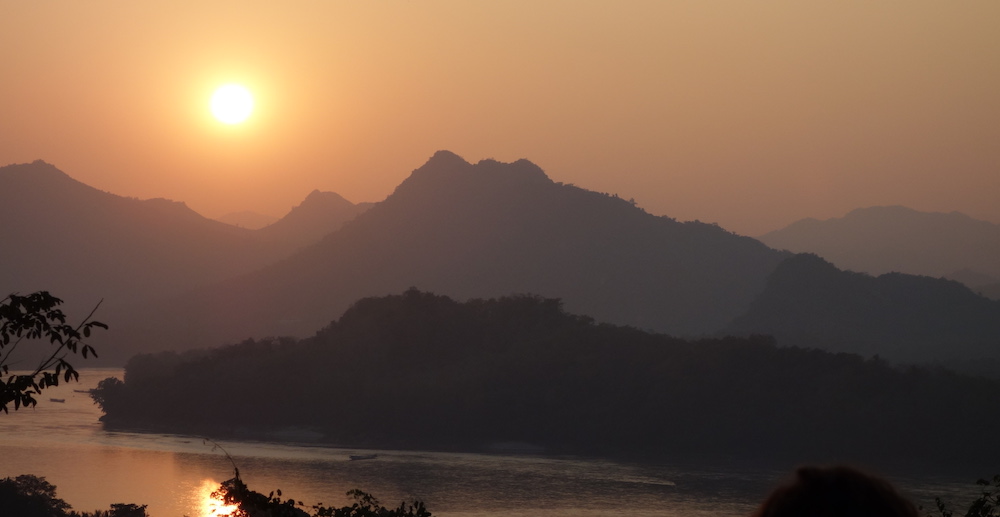 Sunset over the Mekong
Sunset over the Mekong